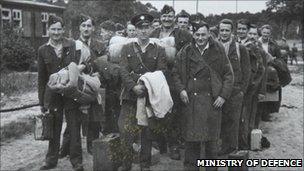By George! Fourth Great Escape tunnel to be excavated
- Published

Stalag Luft III held more than 10,000 Allied prisoners of war
Tom, Dick and Harry famously had their stories told in the film The Great Escape, but more is soon to be learned about a little-known fourth tunnel.
This spring, a British team is due to excavate "George", at the site of the Stalag Luft III camp in Zagan, Poland.
The tunnel was built after the March 1944 escape by 76 Allied prisoners that is portrayed in the film starring Steve McQueen, but never used for an escape.
Historian Dr Howard Tuck says George represents the camp's "final chapter".
Dr Tuck, a project leader on the excavation, said it could be considered "the most dangerous tunnel of the war".
For much of World War II, prisoner escape attempts had been an accepted part of the conduct of the conflict.
But after the Stalag Luft III escape in March 1944, Adolf Hitler personally ordered the execution of 50 of the escapees in order to deter other prisoners of war (POWs) from doing the same.
"The murder of the 50 sent shockwaves through the POW community," Dr Tuck says. "The Germans were in no mood to mess around.
"Those involved in engineering this tunnel or trying to escape were going to face the harshest consequences."
The 1963 film The Great Escape, which also starred Sir Richard Attenborough and James Coburn, ends with the caption: "This picture is dedicated to the fifty."
'Uber-secret'
Dr Tuck believes George was begun in about September 1944, before the arrival of freezing conditions in winter that would have made digging impossible.
Stalag Luft III held more than 10,000 RAF and US air force prisoners, and it is estimated about a third would have assisted in preparations for the Tom, Dick and Harry breakout.
Far fewer would have worked on, or even known about George, Dr Tuck believes.
"This tunnel was uber-secret, this was another level of secrecy," he says, which partly explains why so little is known about the tunnel.
"Those that actually knew about it are very thin on the ground."
But two or three veterans who were involved will join the excavation later this year, Dr Tuck says.
It was a "contingency tunnel", he believes, built amid POWs' growing fear that the advance of the Russian army might prompt their German captors to turn on them.
It could have been used to store possible weapons as well as items for an escape through the tunnel, if that was deemed necessary.
No escape ever took place because, in January 1945, the retreating German army forced thousands of POWs on the infamous "Long March" back to Germany in freezing conditions. About 200 men died.
One veteran has told Dr Tuck he remembers putting a radio set in the tunnel, and the historian believes the excavation could also uncover forged documents, clothing, tools and food.
"This really is the final chapter in the history of the camp, and very, very little is known about it," says Dr Tuck.